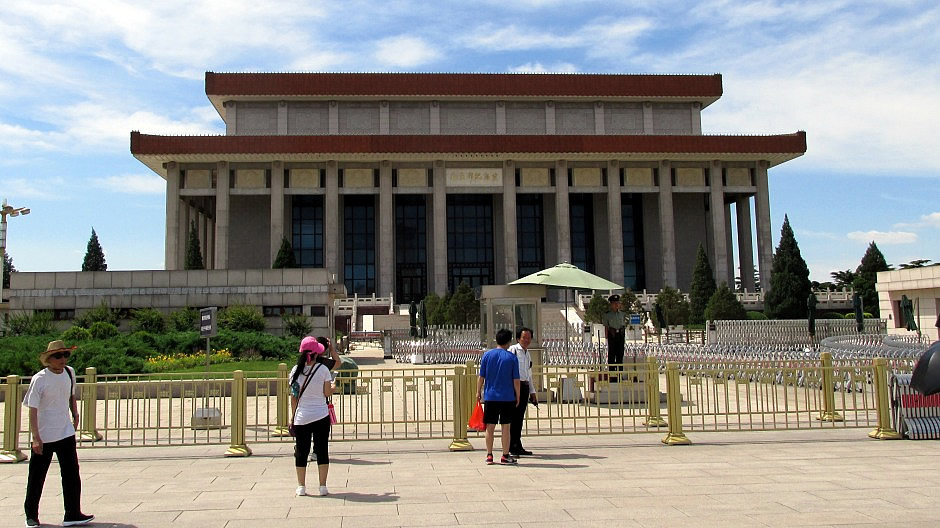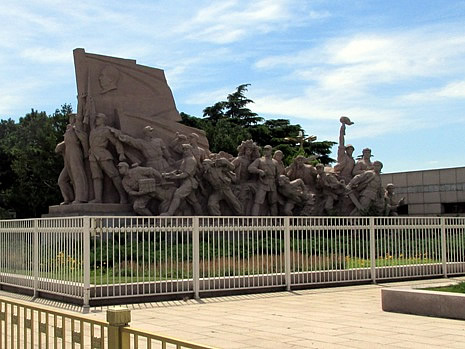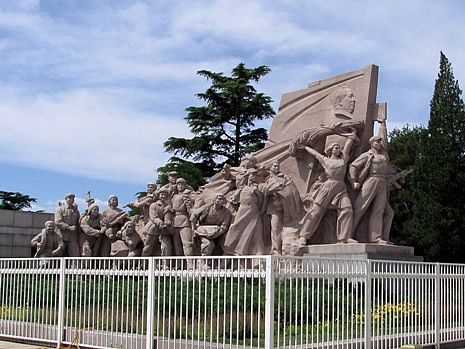
Above: Panoramic Stitch (Stereographic Projection) of Tiananmen Square Looking Northwards from Outside the Mao Zedong Memorial Hall
Tiananmen Square (Tiananmen Guangchang) was once the world's largest public square and is situated in the centre of Beijing, China. Still one of the largest in the world, it was originally designed and built in 1651 during the Qing Dynasty (1644-1912). The square's name comes from the Tiananmen ('Gate of Heavenly Peace') which was first constructed in the 15th century during the Ming Dynasty (1368-1644) at the same time as the construction of Beijing City . This gate is situated at the northern end of the square and was once the main gate to the Forbidden City (the Chinese Imperial Palace from the Ming dynasty to the end of the Qing dynasty (1420 to 1912)). In 1958, it was enlarged to four times its size and today is capable of holding 1 million people. The square, which measures some 880 by 500m, is laid out on a north-south axis, like Chinese temples are, employing a conventional layout that is in keeping with tradition, whilst it's ornaments and buildings are mainly Soviet-inspired. Tiananmen Square is suitable for large gatherings of people; it has been the site of a number of political events, mass military displays and student protests. On this webpage, we will take a brief look at the main sites in and on, what is considered to be the symbolic centre of the Chinese Universe.

Above: Tiananmen (Gate of Heavenly Peace)
Tiananmen ('Gate of Heavenly Peace') is a world famous gate which stands at the northern end of Tiananmen Square. Due to Tiananmen 's historical importance, it is featured on the National Emblem of the People's Republic of China. It was first built in 1420 and over the years underwent several periods of reconstruction and renovation, although the design we see today dates from 1465. Although often referred to as the front entrance to the Forbidden City, Tiananmen was actually the entrance to the Imperial City. The Forbidden City was located inside the Imperial City and so it's actual front gate was the Meridian Gate (Wumen) which is just beyond it, still along the same north-south axis as Tiananmen and the square which is named after it.
From Imperial days, the gate served as a rostrum for proclaiming the assembled masses and it is from here these days, the political elite still review the gigantic military parades that take place on the square. Tiananmen measures 66m long, 37m wide and stands 32m high and there are 5 passageways through the gate, fronted by the Golden River Bridges which span a moat. According to Imperial protocol, only the emperor was able to pass over the central bridge and through the gate's central passageway; lesser officials and citizens had to use the smaller side passageways. Post-Imperial days, it was from Tiananmen that Chairman Mao proclaimed the People's Republic on 1at October, 1949. Since 1949, a large portrait of Mao has been famously hung on the front of Tiananmen. There have been the occasional exceptions, such as in March 1953, when a picture of Joseph Stalin was put up marking his death. Left of Mao's portrait reads the slogan (in Chinese) 'Long Live the People's Republic of China' whilst to the right reads 'Long Live the Great Unity of the Peoples of the World'. Gigantic stone lions stand in front of the gate, believed in Chinese culture to protect humans from evil spirits and also seen here are two stone decorative columns each with an animal on the top. The gate also has a unique decorative roof, in line with other official buildings of the time. It is possible to buy a ticket to climb the gate for views of the square although there is no fee to walk through it towards the Forbidden City.

Above: Monument to the People’s Heroes
In the centre of the square on the site of the old Outer Palace Gate stands the Monument to the People’s Heroes. The monument was completed in 1958 and comprises a 38m high Qingdao granite obelisk, standing on a two-tiered marble terrace. It was the first large-scale monument commissioned by Mao to be built in the ‘new’ China. The monument bears bas-relief carvings of key revolutionary events and commemorates the masses that died revolting against the country’s oppressors; turning points vital in establishing the People's Republic. The monument bears the inscription "The People's Heroes are Immortal", written in Mao's own calligraphy.
 |
||
 |
 |
|
Above: The Mao Zedong Memorial Hall (Mausoleum) and Sculptures Standing Outside
The Mao Zedong Memorial Hall, or Mao Zedong Mausoleum, stands in the square towards it’s southern end and just south of the Monument to the People’s Heroes. The hall was completed 1977 shortly after Chairman Mao Zedong, the founder of the People’s Republic of China, died (in September 1976) and here, his embalmed body lies in state. Like Lenin’s Mausoleum in Moscow’s Red Square, it is open to the public to view the waxy-looking former leader, except for certain times of the year when the body is undergoing maintenance. For a biography on Mao Zedong (sometimes written as ‘Mao Tse-tung’), click here (external link). Outside the memorial hall stand sculptures which supplement the artistic rendering of national struggle re2opresented on the nearby Monument to the People's Heroes.

Above: The National Museum of China
On the eastern side of the square stands the imposing National Museum of China. As one might expect from the name, it is one of the largest museums in the world. The museum complex was established in 2003 as a result of combining the former Museum of the Chinese Revolution, which opened in 1950, and the National Museum of Chinese History, which opened in 1912, into one single institution. The Museum of the Chinese Revolution was dedicated to Chinese history since about 1840, whilst the National Museum of Chinese History was dedicated to Chinese history from its earliest beginnings until the Chinese Revolution. The National Museum of China today is designed to educate people about the arts and history of China all the way from the Yuanmou Man of 1.7 million years ago to the end of the last Imperial dynasty (Qing Dynasty (1644-1912). It underwent extensive renovation and reopened in 2011 with many new modern exhibition halls, creating over three times the exhibition space than previously and bringing the total floor space to nearly 200,000m². Over a million items are now on permanent display here. There are many, many important items on display and they include bronzeware from the Shang and Western Zhou Dynasties, many ancient ceramics, a gold-inlaid bronze tally in the shape of a tiger (Qin Dynasty) and jade burial suits sewn with gold thread (Han Dynasty).

Above: Qianmen (Zhengyangmen) - Perhaps a better photo could have been taken!
Qianmen ('Front Gate'), the colloquial name for Zhengyangmen, stands at the southern end of the square. At the time of it's construction in 1421, during the Ming Dynasty, Qianmen was one of the gates of the Imperial City Wall. As with the Tiananmen, only the emperor was allowed to use the central passage. The gate was damaged by fire in 1780 and 1849 and was nearly destroyed during the Boxer Rebellion on 1900. Careful 20th century rebuilding has restored Qianmen to it's former glory. Although much of the Imperial City Walls were demolished, Qianmen remains an important geographical marker of the city.

Above: The Old Bank of China Building
The Old Bank of China Building stands on the western side of Tiananmen Square, just south of The Great Hall of the People

Above: The Great Hall of the People
On the western side of the square stands the Great Hall of the People, which was completed in 1959. It is the site of the rubber-stamp legislature, the National People’s Congress and contains a meeting hall with more than 10,000 seats and a banquet hall which can seat 5,000. The architecture is monolithic and creates the same authoritative statement to the onlooker as one often gets from Soviet-style buildings. As one might expect, the building is closed to visitors when the congress is in session, but more often than not, it is open daily from 9am to 2pm when visitors get a chance to take a tour through not only the meeting and banquet halls, but also a number of rooms, each named after a province of China.

Above: A Refreshment Van Serves Passersby on the Square’s Perimeter
For visitors to the square who are able to get there for sunrise, a flag-raising ceremony takes place daily by a troop of People’s Liberation Army soldiers whose perfected timing is drilled to march at 108 x 75cm paces per minute. The same ceremony is performed at sunset, although as one might expect, the area is far more crowded. At night time, the square is brightly lit up.
 |
 |
|
 |
 |
|
 |
Above: A Selection of Photographs Taken from Around the Square
Tiananmen Square may be accessed in a number of ways and is via tight security checkpoints. Line 1 of the Beijing Subway has stops at Tiananmen West and Tiananmen East on it's northern side on Chang'an Avenue, whilst Line 2's Qianmen Station is directly south of the square. There are a very large number of bus routes that run here as well. It is not possible to cycle on the square itself.

Further Reading
1. Schellinger, Paul E, Robert M Salkin, and
Trudy Ring. Asia And Oceania. Chicago [u.a.]: Fitzroy Dearborn Publ.,
1996. Print.
2. To search for further information on the square's long
and fascinating history, click on this external link
here.

Back to Top